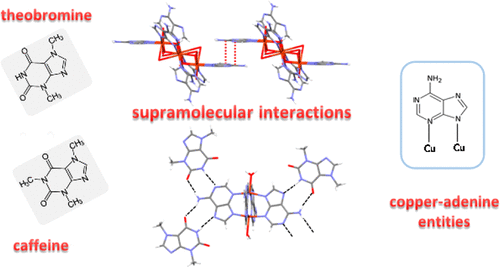当前位置:
X-MOL 学术
›
Cryst. Growth Des.
›
论文详情
Our official English website, www.x-mol.net, welcomes your feedback! (Note: you will need to create a separate account there.)
Porous Supramolecular Architectures Based on π-Stacking Interactions between Discrete Metal-Adenine Entities and the Non-DNA Theobromine/Caffeine Nucleobases
Crystal Growth & Design ( IF 3.8 ) Pub Date : 2018-04-24 00:00:00 , DOI: 10.1021/acs.cgd.8b00188 Jon Pascual-Colino 1 , Garikoitz Beobide 1 , Oscar Castillo 1 , Ivan da Silva 2 , Antonio Luque 1 , Sonia Pérez-Yáñez 3
Crystal Growth & Design ( IF 3.8 ) Pub Date : 2018-04-24 00:00:00 , DOI: 10.1021/acs.cgd.8b00188 Jon Pascual-Colino 1 , Garikoitz Beobide 1 , Oscar Castillo 1 , Ivan da Silva 2 , Antonio Luque 1 , Sonia Pérez-Yáñez 3
Affiliation

|
This work is aimed at the analysis of the π–π stacking interactions as the driving force to develop porous supramolecular metal–organic frameworks (SMOFs) as an alternative to more directional hydrogen bonding interactions. Four compounds based on the interaction between rigid copper/adenine entities and theobromine/caffeine molecules have been synthesized: [Cu7(μ-ade)6(μ3-OH)6(μ-H2O)6](theo)2·∼28H2O (1), [Cu2(μ-ade)4(H2O)2]·3Htheo·∼7H2O (2), [Cu2(μ-ade)4(H2O)2]·2Htheo·∼18H2O (3), and [Cu2(μ-ade)4(H2O)2]·(caf)·∼6H2O (4). The blue compound 1 is formed by wheel-shaped cationic heptameric units where the copper atoms are bridged by hydroxide anions, water molecules, and adeninato ligands with a μ-κN3:κN9 coordination mode. The assembly of the heptameric entities and the theobrominate anions takes place mainly through π–π stacking interactions involving the adeninato ligands and theobrominate moieties. Although compound 1 exhibits an open-framework with voids representing 37% of the unit cell, the plasticity of the π–π interactions causes a reversible shrinkage of the porous system upon activation that precludes the adsorption of gas molecules. Dark purple compounds 2–4 contain neutral windmill units in which two copper atoms are bridged by four μ-κN3:κN9 adeninato ligands. Their final crystal structure highly depends on the supramolecular interactions of the theobromine and caffeine molecules. In compound 2, two theobromine molecules are hydrogen bonded to the Hoogsteen face of two trans-arranged adeninato ligands, whereas a third theobromine molecule is joined to the Watson–Crick face of one of the previous adeninato ligands. In compound 3, with a lower amount of theobromine, the Watson–Crick interaction is not present. In both compounds, the three-dimensional (3D) crystal structure requires the additional presence of π–π stacks between the theobromine molecules. In compound 4, as the methyl groups of the caffeine molecule do not allow hydrogen bond interactions, the adeninato ligands are hydrogen bonded among them to generate, together with π-stacking interactions, two-dimensional supramolecular sheets containing rectangular windows in which the caffeine molecules are located. Only compound 4 showed permanent porosity, adsorbing a significant amount of CO2 (0.88 mmol of CO2/g at 5 bar and 273 K). The magnetic characterization of these compounds indicates a ferrimagnetic behavior for 1 and strong intradimeric antiferromagnetic interactions in compounds 2 and 4.
中文翻译:

基于离散金属-腺嘌呤实体与非DNA可可碱/咖啡因核糖核酸酶之间的π-堆叠相互作用的多孔超分子体系结构。
这项工作旨在分析π-π堆积相互作用,以此作为发展多孔超分子金属-有机骨架(SMOF)的驱动力,以替代更具方向性的氢键相互作用。已经合成了基于刚性铜/腺嘌呤实体和可可碱/咖啡因分子之间的相互作用四种化合物:[铜7(μ-ADE)6(μ 3 -OH)6(μ-H 2 O)6 ](西奥)2 · 〜 28H 2 O(1),[铜2(μ-ADE)4(H 2 O)2 ]·3Htheo· 〜 7H 2O(2),[铜2(μ-ADE)4(H 2 O)2 ]·2Htheo· 〜 18H 2 O(3)和[铜2(μ-ADE)4(H 2 O)2 ]· (caf)·〜6H 2 O(4)。蓝色化合物1是由其中的铜原子被氢氧根阴离子,水分子和配体adeninato用μ-κ桥接轮状阳离子七聚体单元形成N3 κ:N9协调模式。七聚体和可可溴阴离子的组装主要通过涉及腺嘌呤配体和可可溴部分的π-π堆积相互作用进行。尽管化合物1表现出开孔结构,其空隙占单位晶格的37%,但π-π相互作用的可塑性会导致活化后多孔体系的可逆收缩,从而阻止了气体分子的吸附。暗紫色的化合物2 - 4包含其中两个铜原子由四个桥接的中性风车单元μ-κ N3:κ N9 adeninato配体。它们的最终晶体结构高度取决于可可碱和咖啡因分子的超分子相互作用。在复合如图2所示,两个可可碱分子与两个反式排列的腺嘌呤配体的Hoogsteen面氢键结合,而第三个可可碱分子与先前的一个腺嘌呤配体的Watson-Crick面连接。在化合物3中,可可碱含量较低,则不存在Watson-Crick相互作用。在这两种化合物中,三维(3D)晶体结构都需要可可碱分子之间存在π–π堆栈。在化合物4中由于咖啡因分子的甲基不允许氢键相互作用,因此腺嘌呤配体之间通过氢键结合π堆叠相互作用产生了二维超分子薄片,该薄片包含了咖啡因分子所在的矩形窗口。仅化合物4显示出永久的孔隙率,吸附了大量的CO 2(在5 bar和273 K下吸附0.88 mmol CO 2 / g)。这些化合物的磁性表征表明1具有亚铁磁性,化合物2和4具有较强的二聚体反铁磁性相互作用。
更新日期:2018-04-24
中文翻译:

基于离散金属-腺嘌呤实体与非DNA可可碱/咖啡因核糖核酸酶之间的π-堆叠相互作用的多孔超分子体系结构。
这项工作旨在分析π-π堆积相互作用,以此作为发展多孔超分子金属-有机骨架(SMOF)的驱动力,以替代更具方向性的氢键相互作用。已经合成了基于刚性铜/腺嘌呤实体和可可碱/咖啡因分子之间的相互作用四种化合物:[铜7(μ-ADE)6(μ 3 -OH)6(μ-H 2 O)6 ](西奥)2 · 〜 28H 2 O(1),[铜2(μ-ADE)4(H 2 O)2 ]·3Htheo· 〜 7H 2O(2),[铜2(μ-ADE)4(H 2 O)2 ]·2Htheo· 〜 18H 2 O(3)和[铜2(μ-ADE)4(H 2 O)2 ]· (caf)·〜6H 2 O(4)。蓝色化合物1是由其中的铜原子被氢氧根阴离子,水分子和配体adeninato用μ-κ桥接轮状阳离子七聚体单元形成N3 κ:N9协调模式。七聚体和可可溴阴离子的组装主要通过涉及腺嘌呤配体和可可溴部分的π-π堆积相互作用进行。尽管化合物1表现出开孔结构,其空隙占单位晶格的37%,但π-π相互作用的可塑性会导致活化后多孔体系的可逆收缩,从而阻止了气体分子的吸附。暗紫色的化合物2 - 4包含其中两个铜原子由四个桥接的中性风车单元μ-κ N3:κ N9 adeninato配体。它们的最终晶体结构高度取决于可可碱和咖啡因分子的超分子相互作用。在复合如图2所示,两个可可碱分子与两个反式排列的腺嘌呤配体的Hoogsteen面氢键结合,而第三个可可碱分子与先前的一个腺嘌呤配体的Watson-Crick面连接。在化合物3中,可可碱含量较低,则不存在Watson-Crick相互作用。在这两种化合物中,三维(3D)晶体结构都需要可可碱分子之间存在π–π堆栈。在化合物4中由于咖啡因分子的甲基不允许氢键相互作用,因此腺嘌呤配体之间通过氢键结合π堆叠相互作用产生了二维超分子薄片,该薄片包含了咖啡因分子所在的矩形窗口。仅化合物4显示出永久的孔隙率,吸附了大量的CO 2(在5 bar和273 K下吸附0.88 mmol CO 2 / g)。这些化合物的磁性表征表明1具有亚铁磁性,化合物2和4具有较强的二聚体反铁磁性相互作用。



























 京公网安备 11010802027423号
京公网安备 11010802027423号